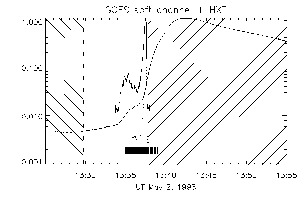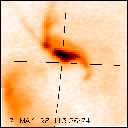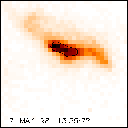Impulsive X flare, retrospective
Science Nugget: Mar 12, 1999
1. Earlier study
The first look at this event
focused mainly on the comparison between preflare and postflare active-region
structure, and on the mass motions observed in coincidence with the launching
of a halo CME. Please see those pages for links to some of this material.
2. Why look again?
Would this flare be detectable as a large-scale coronal wave? The SXT team
has become excited about this kind of thing, old hat to EIT and to radio
astronomers of course, because of the possible
detection of a wave in another May 1998 flare from the same active
region, NOAA 8210, when it was near its W limb passage. Please see the
NOAA event listings for detailed summaries of
both events.
3. What we see
The plot below gives the time line of Yohkoh observations, superposed
on the ever-reliable GOES soft X-ray photometry.

The hatched regions show (left and right) a passage of Yohkoh
through the South Atlantic Anomaly, and orbit night. The flare onset was
interrupted by the Earth's shadow, which produced the sharp drop in the
HXT low (13-23 keV) and M1 (23-33 kev) channels shown, the latter with
a factor of ten displacement for visibility. No doubt the Neupert effect
is working well here! Because of the design of its spectral passbands,
one can read off the hard X-ray spectral index from the ratio of M1 to
L: equal counts corresponds roughly to a photon number spectral index of
2.0. This very impulsive event has, as expected, a very hard spectrum.
Tick marks at the bottom of the plot show soft X-ray image times.
The flare development was eruptive, but with an interesting pattern.
The brightest ejection proceeded almost directly towards disk center, from
the flare location at S15, W15; this implies a large inclination angle
to the local vertical. The ejection included a sinuous jet structure and
obvious flow to the northeast, both there and to the north of the jet.
The jet seemed to be anchored in bright point somewhat distant from the
brightest flare loop. Here's the movie in the half-resolution data, .gif
format at 150 kB:

| The flare itself (image at right, at full resolution) consisted initially
of the bright loop seen just to the north of the (S15,W15) intersection
of heliospheric grid lines (N.B. - approximate!). This is a 28-msec exposure
in the AlMg filter. The jet can be seen faintly to the NE of this loop,
and the sigmoidal curl (direct S because it's southern hemisphere) is clearly
visible. |
 |
 |
The image at left, in the SXT Be filter, shows a blow-up of the central
32x32-pixel region (image width ~60,000 km), with a contour showing the
half-maximum level. This is the bright loop that dominates the rise phase
of this flare. |
4. Momentum estimates
Well, this is an interesting subject, but beyond the scope of a "science
nugget" that really should be comprehensible to almost anybody with a technical
bent and an interest in things that go whizz-bang on the Sun. We have several
views of large-scale waves emanating from flares -
Type II bursts, known from early meter-wave radio astronomy to be large-scale
coronal waves with speeds in excess of plausible Alfven speeds;
Moreton waves, a collection of H-alpha signatures emanating from the flare
impulsive phase (H-alpha means the chromosphere, of course, but the Uchida
interpretation of the Moreton wave is that it's the skirt of the coronal
wave;
EIT waves, true coronal waves seen beautifully and in abundance by SOHO
EIT;
MDI waves, actual photospheric running waves (seismic disturbances) launched
by the pressure pulse of the flare;
Interplanetary shock waves, known now to be driven by the CME as it moves
through the solar wind.
The key to understanding how flares launch such waves is probably in
the momentum generated by the process. So at first glance, everyone will
immediately understand why this subject is at the frontier of research:
people can use the term "magnetic explosion" to describe a flare, which
indeed shoots stuff outwards in all directions. So, observationally it's
appropriate. But the same people would be certain that flare energy derives
from stored magnetic energy, and to convert it into visible form clearly
requires a "magnetic implosion"! From this juxtaposition it is clear that
there may be some uncertainty about what is happening at the core of a
flare, so please stay tuned for future science nuggets that will continue
this interesting story.
March 14, 1999: Hugh Hudson (email hudson@isass0.solar.isas.ac.jp)


